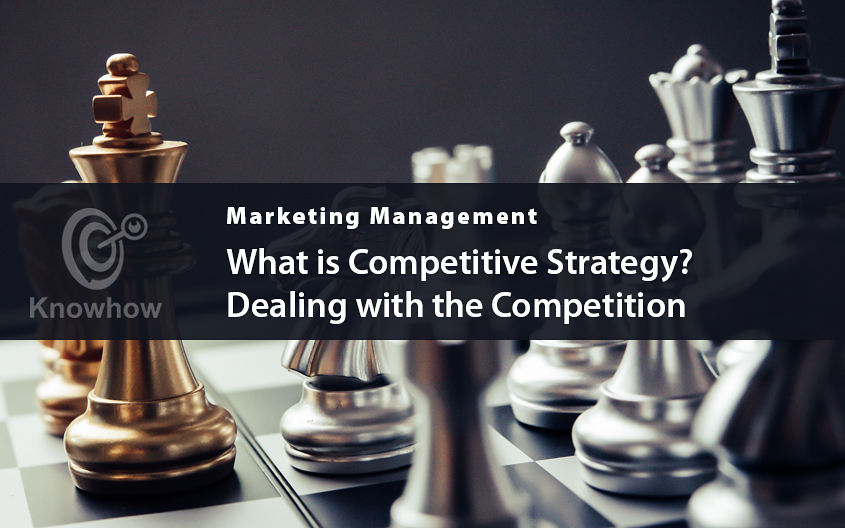
Every business market and every single consumer in a market has a set of distinct attributes. And customers function by those attributes. Not so long ago, a company was able to thrive by simply understanding the characteristics of their consumers.
Nowadays, it’s no longer that simple. In the modern era where technology is taking over and companies are growing beyond the boundaries of their original countries, it is of utmost importance to understand the competition more than ever.
For example, a large number of companies are cutting down on costs by outsourcing production processes. By moving the manufacturing process to Asian countries, they are able to gain a competitive edge. Companies that don’t do the same have to find other ways or strategies to compensate for the difference.
So what is competitive strategy?
Let’s take a look at this now in more detail and break it down.
The Five Force Model
Identifying the competitive forces in an environment is a good place to start dealing with the competition. The five force model by Michael Porter can help in this task. These are the five sources of threat in the five force model:
- Existing forces in the same segment
These forces can become a threat if the segment already has too many existing players. Namely, a segment that is reaching saturation makes the competition a lot riskier than “emptier” segments.
- New entrants to the segment
If the entry barrier to the segment is too low and companies can just waltz in, it can lead to over-saturation. However, if the barriers are very high, any new entrants will be very competitive from the get-go.
- Substitute products
Substitute products can be a threat in and of itself. However, they can further diminish the potential profits of the company by limiting the price increases. After all, no company can afford to be too far ahead of the competition in the price department.
- Increase in the bargaining power of consumers
If consumers in certain areas are capable of organising themselves, their bargaining power can increase. In that case, they can pressure companies to lower their profit margins.
- Bargaining power of suppliers
Suppliers are crucial to the operation of any company. And if suppliers are low in numbers, they can demand higher prices for their raw materials. Such activities can make a segment unattractive.
Identifying Competition
Companies might deal with any number of the threats we have mentioned above. However, if they can’t properly identify their competition, they won’t be able to stay ahead of it. For decades, identifying competition wasn’t a big issue, but then the era of the Internet came along. A significant number of older companies didn’t want to put an effort into addressing the fact that there are new players in the game. In fact, they didn’t even consider the Internet as a potential source of serious competition.
However, the companies that sell their products online can definitely take a significant market share. Take for example Amazon.com. For years, it wasn’t really a cause for concern for most retailers. However, as it grew, it started taking over larger and larger quantities of customers from retailers such as Target.
Businesses have a habit of looking at competition in a very strict market. On the other hand, advertisers should always look at competition in a holistic manner. Even different products can satisfy similar needs and reduce the market share of certain companies.
Understanding the Competition
In order to survive in the market, companies have to learn about their competitors. Namely, a company has to understand what goals and motives are the driving force behind the efforts of their competitors. Moreover, companies have to learn about the strengths and weaknesses of their opponents. Also, companies have to have a deep understanding of the ways their competitors face challenges.
For those reasons, companies have to develop intelligence systems. These systems are there to analyse the competition. The first step they have to take would be identifying the parameters they should use. Secondly, they should gather any and all information they have. Once they have the data, they can analyse it and forward it to the relevant teams that can make decisions based on that data.
However, designing such a system can be incredibly expensive. So many companies are willing to outsource their intelligence gathering to third parties. Third-party companies that specialise in data collection can do so efficiently and quickly while reducing the overall costs for the company that hired them.
In the end, companies have to understand the way their competition operates. They have to dedicate time, personnel, and resources in order to stay on top of the game. If they fail to do so, they are very likely to see a decrease in profit and market share.
Related content:
Marketing Management Knowhow – learn more about marketing with our collection of educational articles.
From corporate promotional pens, canvas bags, printed umbrellas, branded mugs, logo branded water bottles, branded phone stands, eco-friendly giveaways, clothing, promotional notebooks, toys and novelties and coasters, here at GoPromotional we believe that you are sure to find the ideal promotional products to promote your company.
If however, you require further information or have any specific questions, don’t hesitate to give a member of our experienced team a call on 0800 0148 970 or simply email us today.






